John Eadie Commentaries and Bible Reference Collection (11 vols.)
Digital Logos Edition
Overview
The 11-volume John Eadie Commentaries and Bible Reference Collection contains all of Eadie’s works on the Bible, including five commentaries on the New Testament, plus a biography of Paul, a massive 2-volume history of English Bible translation, a topic concordance, a Bible encyclopedia, and a detailed history of Near Eastern culture. The thorough commentaries will aid both pastors and Greek scholars, and the reference books will aid all readers of the Bible.
John Eadie was an eminent biblical scholar, a master of the Greek text of the New Testament, and an influential Presbyterian minister. During his lifetime, he wrote five New Testament commentaries, which have become standard works on Galatians, Ephesians, Philippians, Colossians, and 1 &2 Thessalonians. Each commentary contains detailed investigations of the text, grammar, and linguistic features of the Greek text. He also provides thorough exegesis and contextual information for each epistle, and demonstrates both Pauline authorship and the coherence of each book.
With the Logos Bible Software edition of Eadie’s commentaries and reference works, you get easier access to the contents of this collection—helping you use these volumes more effectively for research, sermon preparation, and study of the Greek text. Every word from every book is indexed and catalogued. When you double-click on any word in any language, your library opens your preferred lexicon and searches for a match. All Scripture references are also linked directly to your original language texts and English translations. That makes the Logos edition of Eadie’s books and commentaries easier to access for reading, sermon preparation, research, and Bible study.

- Commentaries on Galatians, Ephesians, Philippians, Colossians, and 1 & 2 Thessalonians
- Thorough exegesis of Paul’s texts
- Careful attention to the Greek text
- All Scripture passages linked to the Bibles in your library
- All Greek words linked to your preferred lexicons
On the whole, we have no hesitation in saying that, for full criticism and interpretation, as a repository of the view of nearly all critical interpreters, ancient and modern, on the text of this precious epistle, as well as for sound judgment of his own, for felicitous amplification, evangelic expression, and devout illustration of the sense thus patiently ascertained, this is, for critical students, the best commentary on the Colossians in our language.
—British and Foreign Evangelical Review
His commentaries on the Greek text of many of Paul's epistles have established themselves as classics. Eadie's balanced blend of scholarship and devotion make this a very profitable set for New Testament scholars and students alike.
—F. D. Lindsey, Bibliotheca Sacra
The exegesis is useful for sermon-building or simply feasting on its riches. It should be in every pastor's library.
—Grace Theological Journal
Eadie is well known for his commentaries that resulted from his remarkable preaching ministry.
—John MacArthur, Preaching: How to Preach Biblically
- Title: John Eadie Commentaries and Bible Reference Collection (11 vols.)
- Author: John Eadie
- Volumes: 11
- Pages: 5,251
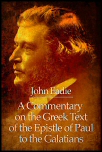
The book of Galatians, says Eadie, is often perceived as promoting a confusing theology. The book combines Paul’s reflections on his experiences, his theology, and a contrast between the Old Covenant and the New—yet it is punctuated by emotional outbursts against the Galatians misconstrual of the Gospel. This makes interpreting Galatians difficult and challenging.
At the same time, an understanding of Galatians and its importance in the New Testament canon is attainable. His commentary on the epistle contains a careful analysis of the Greek text that includes a detailed grammatical and lexical investigation. He shows how the letter reveals both the human elements of its author, yet the important theological implications of the book—all as a unified whole.
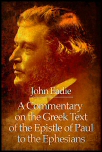
This commentary on Ephesians contains a concise, yet full exposition of Paul’s letter to the Ephesians. Eadie carefully examines the text, the meaning, and the logical sequence of the epistle—as well as its connection with other Pauline literature. He also comments on the particulars of the Greek text, the meanings of words and phrases, and grammatical features of the book.
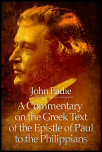
What is the meaning of the book of Philippians? What was the situation in the Philippian church? What is the value and significance of Philippians for us? In this commentary on the epistle to the Philippians, Eadie attempts to expose the personal connection between Paul and the Philippian church, identifying its ongoing implications. Like his other New Testament commentaries, A Commentary on the Greek Text of the Epistle of Paul to the Philippians contains detailed commentary, thorough exegesis, and a meticulous examination of the Greek text.
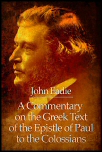
In his introduction, Eadie states that his aim for his Colossians commentary is “to trace and illustrate the thoughts of the writer; to arrive at a knowledge of the truths which he has communicated, by an analysis of the words which he has employed.” This thorough commentary begins with a contextual introduction, followed by detailed commentary on the Greek text. He identifies the thrust of Paul’s ideas in the books and connects them to other Pauline writings.
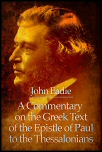
Eadie’s last commentary on the New Testament—on the text of the Thessalonian epistles—is attentive to the minute details of the Greek text. Although he writes in the tradition of the great Greek scholars of his generation, he also provides original research on the text, tracing the arguments in Paul’s thinking and presenting thorough linguistic and exegetical notes. The final completion of Eadie’s commentary on 1 and 2 Thessalonians was interrupted by his death in 1876. Final editing and publication was arranged by his friend, John Cairns, yet the work remains substantially Eadie’s.
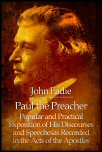
This volume on Paul is unique. It is not a biographical account of his life, nor it is a commentary on the book of Acts. Instead, Eadie explains Paul’s life and grapples with his theology in a practical manner for a general audience. It is a brief and clear exposition of Paul’s intentions as he is portrayed in the book of Acts. Each chapter depicts a scene in Paul’s life, beginning with Damascus and ending in Rome. Eadie’s volume on Paul’s life provides important contextual information for understanding not only the book of Acts, but also the Pauline epistles.
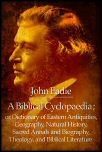
Explore the geography of Palestine through detailed articles and illustration. Understand the cultures of the Ancient Near East. Visualize the Bible with hundreds of illustrations. A Biblical Cyclopaedia, edited by John Eadie, contains articles on nearly every key word in the Bible. First published in 1848, A Biblical Cyclopaedia went through twenty-two edition before a major revision was begun, which included the addition of 300 new articles. This revised and expanded version, published in 1883, is a mammoth reference work, packed with exegetical notes, illustrations, and articles on the prominent people, places, and events in Scripture. It also contains notes on nearly every individual mentioned in Scripture.
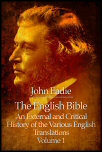
The Bible has appeared in hundreds of English translations throughout the centuries. A handful became the standard translations for their time, and others have remained widely read since their first publication, such as the King James Version and the Douay-Rheims. In the first of his 2-volume work on the history of English Bible translation, Eadie introduces readers to the earliest translations. Beginning with the Anglo-Saxon Bibles, Eadie devotes chapters to Wycliffe, Tyndale, Coverdale, and Thomas Matthew translations. The volume concludes with a chapter on “The Great Bible” translation.
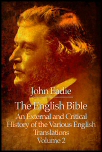
Volume 2 of The English Bible continues Eadie’s history of English Bible translations. This volume contains chapters on the Geneva Bible, the Bishop’s Bible, the Douay-Rheims, and the Authorized Version, the most popular Protestant translation during Eadie’s life time and still widely read today. The second half of this volume argues for a new English translation to replace the Authorized Version. Eadie begins his argument with the theological justification—Scripture is God-breathed and inspired for each new generation. He also shows how new understanding of the original texts expose flaws in the accepted translations of his time. He also points to new translation methods and a better understanding of the elements of Greek—such as articles, tenses, prepositions, and proper names—which would help produce a more accurate, readable, and useful translation.
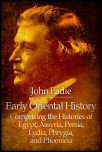
Early Oriental History contains a detailed encyclopedic introduction to Egypt, Nineveh, Babylon, Persia, Lydia, Phrygia, and Phoenicia. Chapters chronicle the ancient history, the geography, the cultural features, the significant events, and the chronologies of each region. This volume also includes biographies of prominent extra-biblical figures, topical treatises (such as a detailed treatise on hieroglyphics), and a complete introduction to the social customs, religion, and language of the cultures of the Ancient Near East. Early Oriental History also contains more than 100 illustrations, and serves as an important reference work for understanding Near Eastern culture.
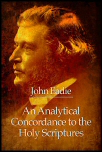
An important aid to the study of the Bible, Eadie’s Analytical Concordance to the Holy Scriptures presents not only a concordance of words, but also arranges Scripture references by subjects. References are grouped under headers and sub-headers to help readers see the internal connection of topics within Scripture itself. These groupings help readers see the themes of Scripture as they relate to each other, and together amount to nothing less than the entire Bible topically arranged. Although the original print edition contained a Bible translation, the Logos edition contains Scripture references, which are linked to the preferred Bible translation in your library.
John Eadie was born on May 9, 1810 at Alva, Stirlingshire, in Scotland. He spent many childhood years as the assistant to Rev. Browning, a local preacher. He studied at the University of Glasgow, where he excelled at the classical languages. Upon graduation, Eadie became an active member of the Succession Church, an influential nineteenth century Scottish Presbyterian denomination, which was later renamed the United Presbyterian Church.
In 1835, Eadie became a minister at the Cambridge Street Church is Glasgow. The church later moved to Lansdowne Crescent in 1863. In addition to his pastoral duties, Eadie became a professor of biblical literature and hermeneutics at the United Presbyterian Divinity Hall, and he received his D.D. from St. Andrews in 1850. During his industrious career at the Divinity Hall, Eadie penned the five New Testament commentaries for which he is best known. His writings contributed to the growing interest in biblical criticism and hermeneutics. Eadie died on June 3, 1876.
Reviews
20 ratings

Dr. Bill Barrick
9/2/2017

Raymond Sevilla
9/22/2015

Pedro J Martinez
2/25/2015
Daniel M. Mandery
9/3/2014
AeliusCicero
6/19/2014
Gary Pajkos
6/11/2014
Dennis Pulley
4/17/2014
Michael Beck
2/26/2014
Rodger
12/12/2013
Shawn Christopher Thornton
12/11/2013